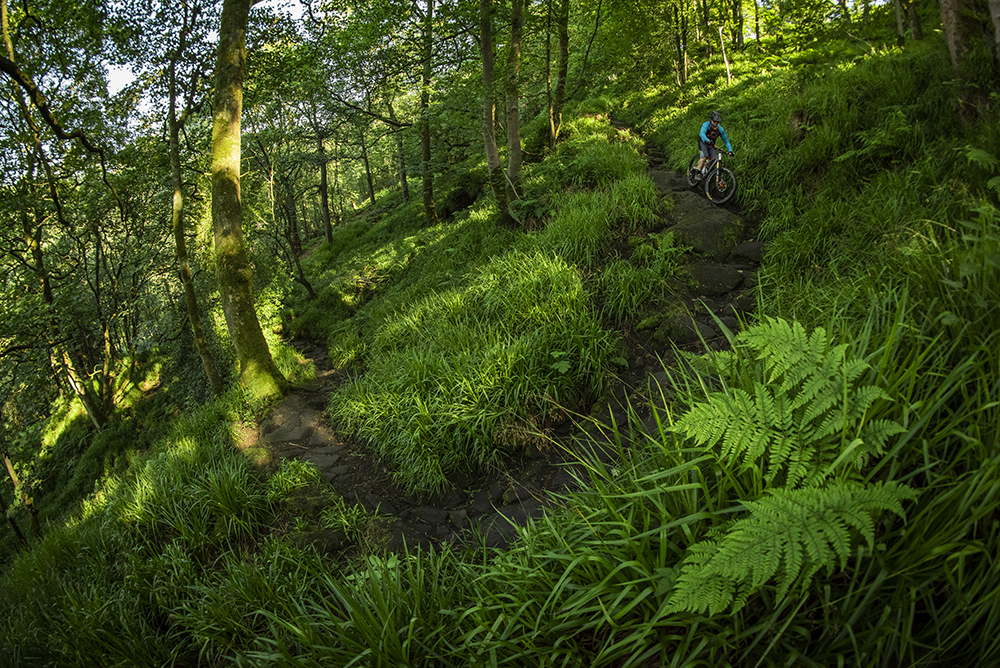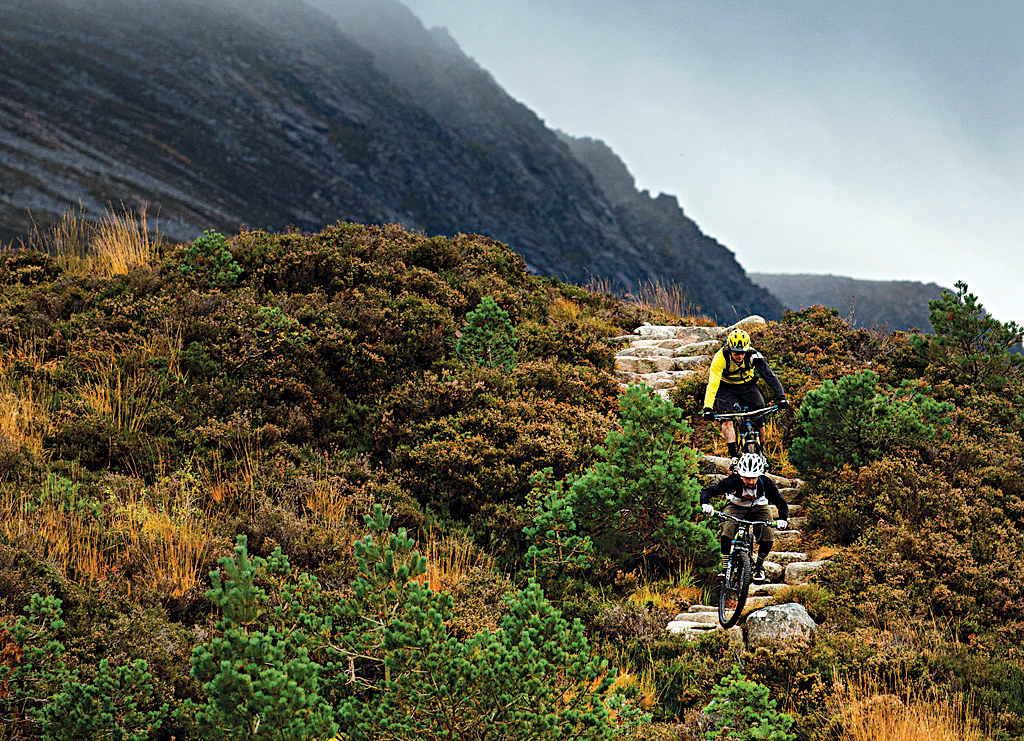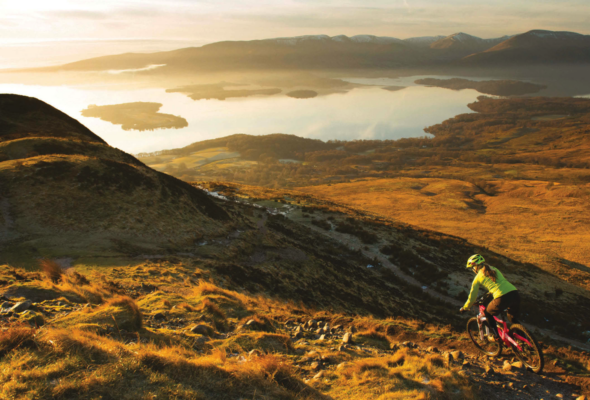Winter can be an incredible time of year for exploring natural trails, especially if you get crisp cold days with blue skies and incredible views. We've picked out a selection that ride well in all conditions.
When days are short and the weather is bad, it’s tempting to stay local, stick to trail centres, or even stay inside. But there are plenty of natural mountain bike routes that are ideal for winter riding, and on a crisp, fresh wintry day there’s nothing like fresh air, a dose of vitamin D, views for miles and a thrilling descent.

Slip-sliding in the Forest of Dean on a winter ride.
As mountain bike media, MBR has been criss-crossing the UK, exploring its best tracks, trails, and paths for over 25 years, and in that time we’ve found plenty of routes that work brilliantly in the depths of winter, and quite a few that don’t! So, using all our experience and expertise, I’ve trawled through the archive and compiled this list of winter-friendly trails.
There’s a mix of wild and wooly epics for the adventurous, long-distance challenges for the brave, and secluded, sheltered, cosy loops ending at a roaring fire in an inviting pub. So without further ado, here are my 12 trail picks for a perfect winter ride.

Winter in the Peak District always makes a splash with visitors.
1. Jacob’s Ladder and The Roych, Peak District
Distance: 24.6km/15.3 miles | Elevation: 554m | Technicality: 8/10
Not that this is news to anyone but it rains a lot in the Peak District, especially over winter. Thankfully many of the trails are made of gritty, grippy rock, so even when the weather is foul the trails hold up well and are still fun to ride. Jacob’s Ladder is one such trail. This makes it the perfect place to test your climbing legs. Sure, it may be more like a stream at some times of year but that just helps make it feel more even more like a trials challenge that demands the subtle application of strength and skill that the best technical climbers possess. This particular route has you going down Jacob’s Ladder, and up some other tricky climbs, but by simply reversing the route you can test your mettle against this Peak classic.
Start in Edale (Landranger 110/SK124853) and head SW on the road before turning S. After that a steep track branches off the road and up Chapel Gate, a techie climb that brings you up onto Rushup Edge over what’s left of the old road. A fun descent takes you NW down through the Roych and out the other side. Turn R at the x-roads on Mount Famine and you’ll drop into Coldwell Clough.
Then it’s a R turn for a brutal climb up to Edale Cross. Then drop your saddle, check your tyre pressures and descend down Jacob’s Ladder back into Edale.
Just remember to ride through the puddles rather than round them to limit erosion, and check out up-to-date trail conditions at Keeper of the Peak.

The low fells around Iron Keld and Holm Ground are like the Lake District in miniature.
2. Hodge Close, Lake District
Distance: 22.0km/13.7 miles | Elevation gain: 600m | Technicality: 6/10
For all its wheel-swallowing peat bogs, the Lake District also boasts a wealth of riding on less permeable terrain. Furness Fells is home to our favourite winter Lake District ride. Although surrounded by giant peaks, this route sticks to the more stunted fells out of the harshest weather and, combined with the fact that it packs a decent distance into a compact area, makes this Lakes route four-season friendly.
Further options to extend this route include adding more singletrack in Grizedale Forest, where there’s also a visitor centre that makes a great lunch stop.
There are plenty of places to refuel after the ride in picturesque Hawkshead.

Dartmoor’s distinctive tors break up the rolling moorland.
3. Burrator Reservoir, Dartmoor
Distance: 24.1km/15.0 miles | Elevation: 462m | Technicality: 6/10
You can start this ride in Princetown if it’s easier, but we reckon it’s best to pass through England’s highest town half way round the ride in winter, so you can refuel or take shelter if need by.
The trails are rocky, fast and perfect for rainy days because the drainage is first class.
Stock up on calories back at Princetown, where there are several cafes to choose from.

Calderdale’s steep, lush hill-sides will keep you on your toes.
4. Calderdale, Pennines
Distance: 23.4km (14.5 miles) | Elevation gain: 654m | Technicality: 8/10
Open an OS map of Calderdale and it’s hard not to see red. This steeply flanked dale in the Pennines is literally riddled with trails, many of them stony or paved with gritstone flags, making the area a premium off-season venue.
Hebden Bridge is a buzzing town with loads of great places to eat, as well as bike shop for spares.

Rocky descents and sweeping vistas are the lifeblood of the Dales.
5. Stockdale Lane, Yorkshire Dales
Distance: 18.1km/11.2 miles | Elevation gain: 509m | Technicality: 6/10
This ride in the South Dales is easy to get to, which can be half the battle on a winter’s day when the weather is bad. It starts in the village of Settle and gets you out onto the fells quickly, with a cracking descent on the bridleway to finish.

The West Highland Way is an ambitious challenge in full, but you can always break it up into sections, like this one at Kinlochleven | Photo: Sam Needham
6. West Highland Way, Fort William
Distance: 55.1km/34.2 miles | Elevation gain: 1,424m | Technicality: 8/10
The West Highland Way delivers some sumptuous singletrack all the way to Kinlochleven, on undulating terrain that we’ve always found to be great fun. This trail gets lots of traffic and so it holds up fairly well to bad weather.
This route does go against the usual flow of the WHW so our advice is to avoid the weekend if at all possible to reduce the number of walkers you’ll encounter.

Snowdonia’s brooding landscape can be at its best in winter.
7. Sarn Helen, Snowdonia
Distance: 21.3km/13.2 miles | Elevation gain: 521m | Technicality: 7/10
Sarn Helen has great all weather surfaces, and together with the epic and tumultuous descent and the fact you get to ride a proper mountain, it’s a real winter winner. Sure it’ll be wet and puddle filled, but the speeds are high and you won’t get bogged down, plus the views are incredible.

Swinley’s singletrack is endless, with a corner around, well, every corner.
8. Swinley Forest, Bracknell
Distance: As long as you like!
Swinley Forest is a popular trail centre with London riders, and for good reason – it’s just about the closest spot to the capital where you can find proper mountain biking. And proper riding there most certainly is, the elevation isn’t high, but the trails here are flowy, rewarding and spicy if you want to tackle the new jump line.
Perhaps most important of all for winter though, the Swinley trails ride just as well when wet as when dry. Better even, as they don’t turn to dust under your tyres. Yes it can get splashy thanks to the low lying land but a good pair of waterproof socks should do the trick. This is our go-to winter riding spot.

Low-flying singletrack in the Cairngorms
9. Glenmore Lodge, Cairngorms
Distance: 34.9km (21.7 miles) | Elevation gain: 1.500m | Technicality: 8/10
The magnificent Cairngorm National Park is one of the UK’s last remaining wilderness mountain environments and, on a crisp winter’s morning, among the sugar-coated peaks and majestic Scots pine, there are few better places to be.
Although prone to bad weather, the underlying granite makes the countless paths and tracks a genuine off-season proposition. With much of the area covered in forest, there’s plenty of sheltered riding to be enjoyed, and the profusion of singletrack radiating from the Forest Visitor Centre at Glenmore means you never have to venture too far from a steaming plate of neeps and tatties.

Powys is home to rolling hills and shaggy moors.
10. Painscastle, Powys
Distance: 20km (12.5 miles)
Route: View and download on Ride With GPS
Shouldering the border with England, Powys is blessed with an extensive network of trails traversing wonderful heather-clad moor. While they may sound barren, the exposure means there’s a consistent wind to blow-dry the trails. For advice on the best rides in the area we turned to Jeremy Atkinson, developer of the route-riddled www.roughrides.co.uk website and organiser of the annual Rough Ride event. Jeremy pointed us toward the Llanbedr Hill area and a route out of Painscastle. Obviously, with no tree cover, you’ll need to plan carefully around the weather before taking on this route. Although the riding will be essentially mud-free, there’s little shelter from the elements once you’re up on the moor.

Sweeping singletrack in the Quantocks.
11. Quantocks, Somerset
Distance: 27.2km (16.9 miles) | Elevation gain: 769m | Technicality: 7/10
In essence the Quantocks are a long ridgeline radiating countless steep, wooded combes, all of which are blessed with the kind of trails that dreams are made from.
The spine is traversed by a well-surfaced track, allowing ready access to the various combes, and most of the best descents end up at a pub – plus you’re never far from the car should there be a need to head home early.
Although the trails frequently criss-cross small streams, most of them sit atop a stony base, and the whole area drains very quickly, so mud shouldn’t be too much of an issue.

Stanage Edge is a Peak District landmark, and gets very busy, so pick your moment.
12. Stanage Edge, Peak District
Distance: 32km (20 miles) | Elevation gain: 846m | Technicality: 7/10
A short route and a bit over-embellished with tarmac to rank among the greats during the summer months, this spectacular Dark Peak loop comes into its own when the nights close in. We spoke to Jon Barton, author of the excellent Dark Peak Mountain Biking guide by Vertebrate Publishing, and he was quick to single out this route as a particular winter fave.

Days like this are what makes winter riding so special. Photo Sam Needham
Winter riding tips – what to take and how to prepare
Most are these routes are low-level, keeping you off the exposed summits, but it’s still advisable to pack appropriate spare clothing, food, and inform someone of your route before heading out, just in case conditions take a turn for the worst.
To keep yourself warm, don’t forget to layer up with a quality base layer and good waterproof jacket, and if you suffer from cold feet then maybe you should consider decent pair of winter riding boots to ensure you retain feeling in your toes!

Andy Barlow bossing the winter conditions in the Tweed Valley.
Winter riding takes a special skillset. You need to ride light, let the bike move around, and not tense up at every little slip and slide. Our skills guru, Andy Barlow, from Dirt School has some pointers here on how to adapt your riding to winter conditions, and what adjustments to make to your bike set-up to optimise for slippery trails.
Bike-wise, make sure you fit a good front mudguard. You can get rear mudguards too, and they’re fine for forest roads and double-track, but if you’re riding technical terrain, it will just get in the way as you move your weight behind the saddle, and it will probably just snap off half way round the first ride.

Swapping to flat pedals in winter can help give you the confidence to push harder.
Swapping to a recommended set of mud tyres is a shrewd move, even if it’s just up front, and think about reducing tyre pressures by 1-2psi for extra grip.
In terms of riding skills, now is the time to brush up on the fundamentals. Body position, weighting and unweighting the bike, and looking ahead and assessing the trail are key to being able to ride confidently in unpredictable conditions. So getting low to the bike to improve your range of motion, keeping your head above the stem, angling your body in the direction of turns, and driving your weight into the trail where grip can be relied on – all of these are basic skills, but really have a profound impact on your winter riding experience.




